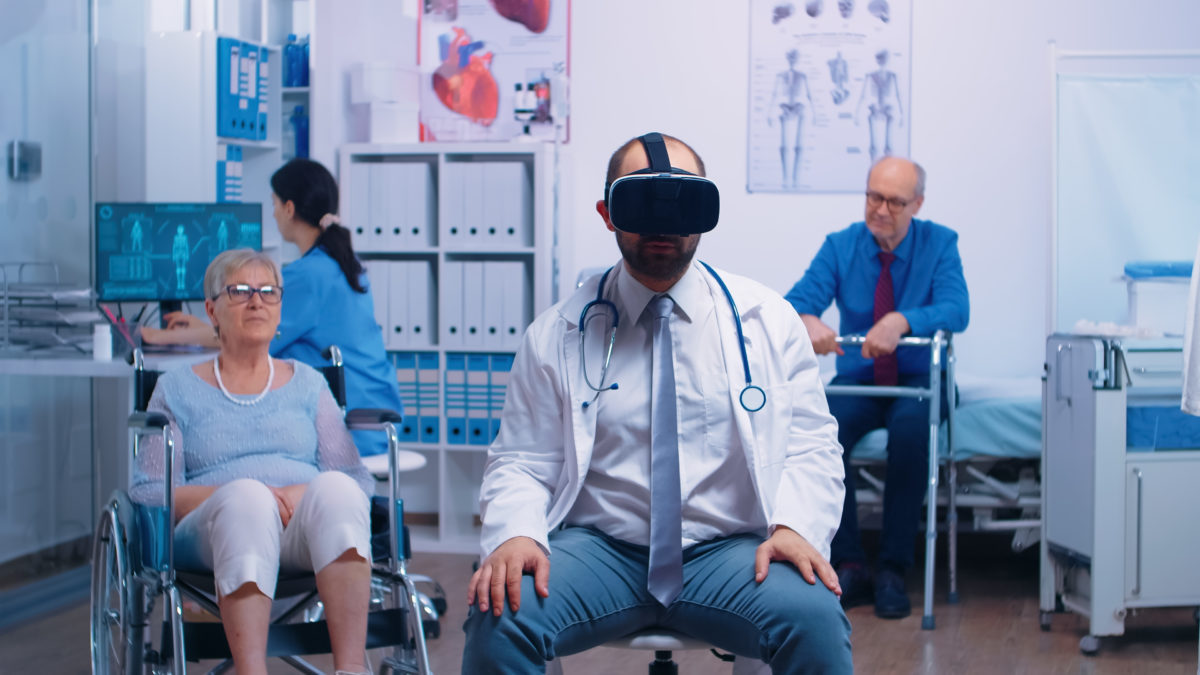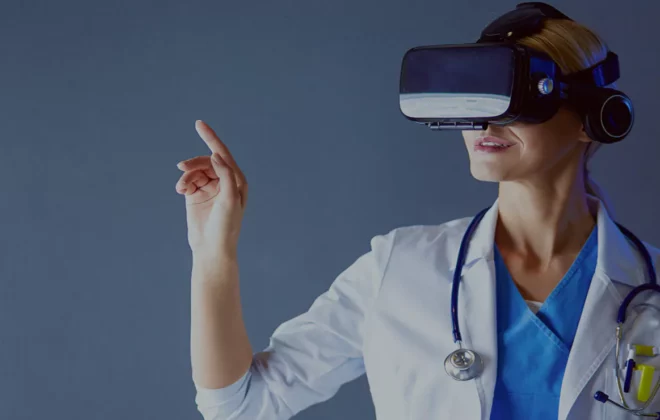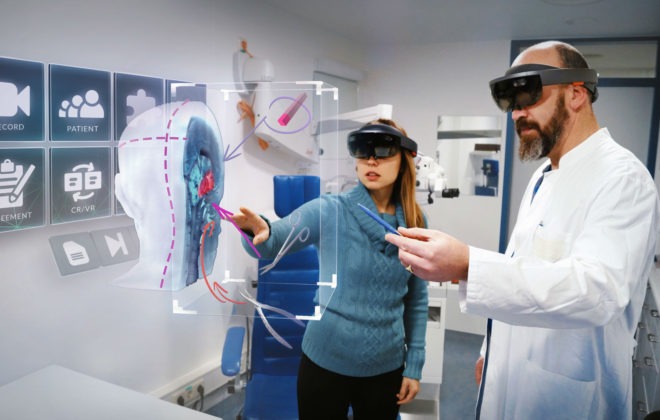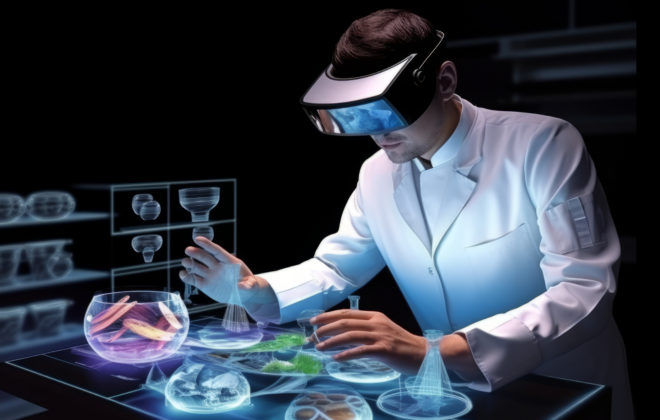The Role of VR in Medical Device Marketing
Virtual reality medical training has been a breakthrough tool in the healthcare sector in recent years as it offers immersive experiences that improve the marketing of medical technologies and the education of healthcare practitioners. This creative technology lets medical device manufacturers provide more powerful training courses and marketing plans by combining interaction with involvement.
Organizations may simplify complex medical processes and gadgets by adopting virtual reality medical education. This enables healthcare professionals and purchasers to grasp and engage with these technologies in virtual, risk-free surroundings.
The many ways VR in healthcare is changing medical device marketing will be discussed in this article. We will go over how VR is revolutionizing training, its advantages for sales and marketing, and how, with technological developments, the future of medical device virtual training looks.
Introduction
With the acceptance of new technology, the healthcare sector is fast changing; virtual reality medical training has become essential to this change. Virtual reality (VR) is becoming vital for medical device marketing and teaching, not just for entertainment value.
The desire for more engaging, interactive, and practical approaches to educating professionals to handle more complicated medical equipment has grown. With 14 million headset units estimated to sell in 2023, one estimate indicates that 90% of the additional income linked with worldwide virtual reality sector expansion would come from hardware sales.
Using a dynamic and realistic experience, virtual reality medical education enables healthcare workers to replicate real-world events free from danger. Particularly medical device firms have seen the possibilities of VR for improving their marketing plans, which will help them to produce more interesting sales presentations and product demos. Using VR technology can help businesses more successfully convey the value of their goods, therefore enhancing sales and consumer happiness.
VR in Medical Device Training and Education
Training and teaching are among VR’s most essential applications in healthcare. Virtual reality medical training allows doctors to learn how to operate sophisticated medical equipment in a virtual environment free of danger. The need for more specific knowledge and expertise has become more critical as medical equipment changes.
☛ Less requirement for personalized training
Medical device training historically needed in-person meetings that took time and were not just expensive. Medical device virtual training, however, allows doctors to now receive immersive, hands-on instruction from anywhere globally. This adaptability lessens the need for physical tools and travel, optimizing the training process and lowering costs.
Furthermore, VR lets medical experts replicate training courses often without any related hazards, guaranteeing their readiness to apply the tools in practical situations. This approach is more inclusive and readily available for a broader spectrum of users as it also suits many learning styles.
☛ Practical VR applications for medical education
Already a mainstay of many healthcare facilities and medical equipment manufacturers’ training curricula is virtual reality. Surgeons may hone their abilities and enhance patient outcomes by practising complex operations in a virtual environment before doing them on humans.
In a completely immersive environment, nurses and other healthcare personnel may also train on running medical equipment such as imaging systems, ventilators, and infusion pumps, lowering the learning curve and the likelihood of mistakes.
VR for Sales and Marketing in The Medical Device Industry
Virtual reality medical training is transforming medical device marketing. Using VR allows businesses to create immersive experiences that enthral their target demographic, therefore allowing them to highlight their goods in ways that are unattainable with more conventional marketing approaches.
From USD 2.4 Bn in 2022 to USD 19.7 Bn in 2032, marketresearch.biz projects that the worldwide Virtual Reality (VR) in healthcare market revenue will rise to a CAGR of 24.1% during the forecast period.
☛ Engaging sales demos
VR’s capacity to generate engaging and immersive sales demonstrations is one of its main benefits for medical device marketing. Companies may utilize VR to let potential consumers or purchasers investigate and engage with medical gadgets in a virtual environment instead of depending only on fixed presentations or video demos. This practical knowledge clarifies for consumers the gadget’s operation, its advantages, and how it fits into medical processes.
Medical virtual reality may, for example, replicate real-life situations wherein medical personnel can see the operation of medical equipment during a surgery or diagnostic process. This helps sales teams more successfully show the features of the gadget and clarifies for consumers how the product might improve their practice.
☛ VR in marketing presentations
Medical device companies also use VR for sales meetings, conferences, and expo marketing presentations. Potential consumers may be taken via VR presentations into a simulated operating room or clinic where they may see the technology in use.
This degree of immersion facilitates a more unforgettable and powerful experience, generating greater attention and involvement. Including VR in their marketing plans will help businesses stand out from rivals and project a company as creative and forward-looking.
Higher revenue and client loyalty may result from VR helping to leave a memorable impact. The worldwide augmented reality and virtual reality in healthcare market size is estimated at USD 3.4 billion in 2023 and is expected to rise at a CAGR of 16.8%.
Benefits of VR in Medical Device Marketing and Training
Virtual reality medical training has several convincing benefits for medical device marketing and education, transforming how medical professionals are educated, and how medical equipment is sold.
☛ Enhanced engagement
In the medical device sector, conventional training and marketing strategies can depend on lectures, written materials, or static demonstrations, which might make it challenging to grab the interest and attention of students or potential consumers. Virtual reality medical training creates highly dynamic and immersive settings that change this experience.
Users of a VR environment become active participants instead of just passive consumers of information. For instance, VR lets medical personnel interact with sophisticated medical equipment in a virtual environment during training on their use.
Without repercussions, they may investigate its features, learn techniques, and even role-play real-life events like surgery. This practical contact significantly increases user participation because individuals learn by doing rather than only viewing.
☛ Increased retention
Especially in medical training, retention of knowledge is very vital. Research indicates that immersive events-such as those provided by virtual reality medical education—enhance knowledge retention compared to more conventional approaches like lectures or reading. This is because VR interacts with many senses-sight, hearing, and sometimes even touch—which makes the learning process unforgettable.
This is crucial in medical training as healthcare practitioners must learn and remember a lot of knowledge, including how to operate sophisticated medical equipment, carry out operations, and handle different circumstances. Through experience learning, virtual reality medical training lets professionals practice and repeat tasks until they reach mastery, imprinting the information in their memory.
☛ Effectiveness of cost
Using VR for marketing and medical device virtual training can help to drastically lower expenses than more conventional approaches. In medical device training, practical learning using actual tools sometimes results in large costs. Businesses must pay for expensive equipment, engage trainers, and often plan travel for trainers and medical experts to attend in-person sessions physically.
VR cuts many of these expenses. Companies may teach consumers in a digital environment without having to provide real medical equipment by building virtual replicas of gadgets. This also lessens the wear and tear on physical tools, which could be costly to repair or maintain.
For instance, when a medical business releases a new piece of diagnostic equipment, they may provide a VR-based training program that lets users practice on a digital version of the gadget instead of sending actual versions to hospitals.
☛ Scalability
The scalability of VR is one of its most solid advantages for marketing and healthcare teaching. Often requiring actual presence, traditional training courses or marketing campaigns restrict their reach and affect the time needed to implement them throughout many sites. This becomes more difficult for big, worldwide businesses that must educate healthcare experts or sell items across many areas.
With little effort, virtual reality medical training is a scalable solution for use worldwide. Virtual reality-generated training courses may be sent digitally, enabling medical professionals from anywhere in the globe to get the same top-notch instruction without travel or the presence of a physical trainer needed.
Medical device businesses that must provide training on new equipment across many countries would especially find this helpful. For instance, when a manufacturer releases new cardiac monitoring equipment, VR may be used to concurrently teach doctors and technicians across many nations, guaranteeing uniform knowledge transfer and minimizing training delays.
The Future of VR in Healthcare and Medical Device Marketing
The function of VR technology in healthcare and medical device marketing will likely become much more as it develops. New trends like combining artificial intelligence (AI) with virtual reality (VR) are poised to transform marketing and training practices completely.
☛ Personalized learning experiences and AI
Including artificial intelligence in virtual reality, medical training is among the most fascinating advancements. By examining a user’s performance in VR training sessions and offering individualized comments, artificial intelligence (AI) may assist medical providers find areas that want work. AI and VR, combined, provide a more customized and efficient learning environment that eventually improves patient outcomes.
☛ Telemedicine and remote diagnostics
Telemedicine is also projected to include VR more extensively, especially for remote diagnostics and virtual procedures. VR lets medical experts work in real-time, anywhere, therefore enabling more effective diagnosis and treatment strategies. By giving physicians and medical personnel the tools and information they need to give high-quality treatment, this technology might also be used to teach them in far-off locations.
☛ The prospect of VR-based marketing
Prospects for medical device marketing seem as bright. Medical equipment manufacturers can offer more realistic and immersive experiences as VR technology develops. This will let companies stand out in a crowded market by showcasing their goods in hitherto unthinkable ways.
Conclusion
Unquestionably, virtual reality medical training has a purpose in medical device marketing. VR will become even more critical in determining the direction of medical device education, sales, and marketing as the marketing and healthcare environments change. From increased engagement to cost-effectiveness, VR’s advantages make it an excellent tool for businesses upgrading their marketing plans and training initiatives.
As artificial intelligence, telemedicine, and virtual diagnostics develop, VR’s promise in healthcare is only starting to be seen. Adopting this technology would help medical device firms with their marketing and training initiatives and help them be leaders in the healthcare sector using innovation.
Experience the future of medical device marketing with Infuse Med’s cutting-edge VR solutions. Transform how you engage with healthcare professionals and showcase your innovations like never before. Ready to take your marketing to the next level? Learn More About Our VR Solutions.
Blog Categories
- 3D Animation (5)
- Company News (2)
- Design Graphics (1)
- Healthcare Operations (7)
- Industry News (9)
- Medical Training (1)
- Sales Enablement (5)
- Software Developing (3)
- Virtual/Augmented Reality (11)







